

| Home | Log In | Register | Our Services | My Account | Contact | Help |
You are NOT currently logged in
dai oldenrich - 01 Sep 2006 13:32
click your browser refresh button to update charts
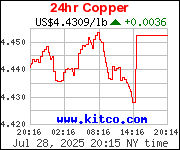
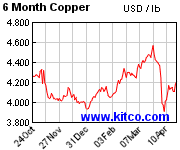
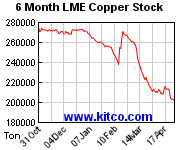
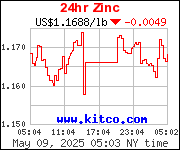
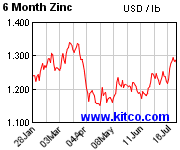
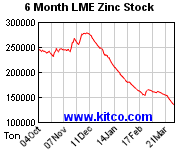
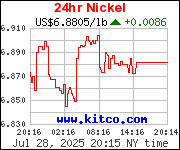
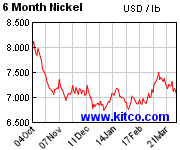
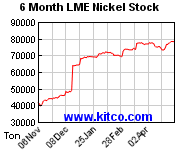
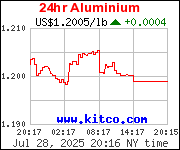
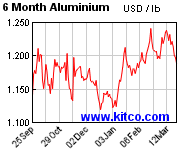
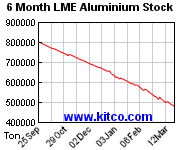
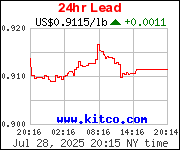
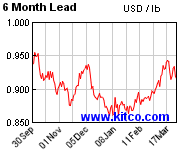
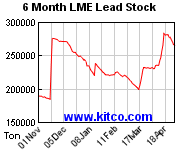
Also see: gold charts here silver charts here platinum charts here
dai oldenrich - 31 Oct 2006 06:48 - 156 of 181
Metals Place - 30 October 2006
Japan's copper cathode inventories rise 5% in September
Japan's inventories of copper cathode totaled 44,363 metric tons in September, up 5.1% on month, according to preliminary data released by the Ministry of Economy, Trade and Industry Friday.
On year, copper stocks were up 14.2%.
According to the data, Japanese smelters produced 122,101 tons of copper cathode in September, down 5.3% from August, but up 5.1% from a year ago.
dai oldenrich - 31 Oct 2006 06:49 - 157 of 181
Oct. 30 (Bloomberg)
Copper Falls Most in Two Weeks After Inventory Gain - By Chanyaporn Chanjaroen
Copper prices fell the most in almost two weeks as rising inventories renewed speculation that mine output may exceed demand this year.
Inventories of copper tracked by exchanges in London, New York and Shanghai rose to 190,024 metric tons today, the highest since the end of March. Supplies from mines and scrap yards will top demand by 146,000 tons next year, the first surplus since 2002, Mitsui Bussan Commodities Ltd. said Oct. 6. Prices that reached a record in May are down 3.5 percent the past two weeks.
``Copper has been looking for a pullback as more metal has been creeping into warehouses,'' said Alex Heath, head of base metals at RBC Capital Markets in London. Heath has been in the metals industry for three decades.
Copper for delivery in three months fell $100, or 1.3 percent, to $7,370 a ton on the London Metal Exchange, the biggest drop since Oct. 17. Copper, used in wire and pipe, is down 16 percent since reaching a record $8,800 on May 11.
On the Comex division of the New York Mercantile Exchange, copper for December delivery fell 4.65 cents, or 1.4 percent, to $3.3585 a pound, the biggest drop for a most-active contract since Oct. 17. A futures contract is an obligation to buy or sell a commodity at a fixed price for a specific delivery date.
Asian Stockpile Gains
Stockpiles tracked by the LME alone have jumped 18 percent since Oct. 18 to 129,475 tons. As much as 86 percent of total LME-monitored stockpiles are in South Korea and Singapore, the nearest warehouse locations to China, the world's largest copper user.
``Consumers have been very quiet, especially from China,'' Heath said.
A settlement of a labor contract at a Codelco unit also eased the risk of a supply disruption, Heath said. Codelco, the world's largest copper producer, reached an agreement with a union representing 394 supervisors at its El Teniente mine in central Chile.
The union on Oct. 27 approved a 42-month contract that will increase wages by 3 percentage points over inflation, union Secretary Manuel Kuwahara said. Chilean annual inflation was 2.8 percent in October. The contract also includes a bonus payment of 6.5 million pesos ($12,344), Kuwahara said.
The El Teniente settlement followed successful talks at other Chilean mines, including BHP Billiton Ltd.'s Escondida, the world's largest copper mine. Codelco's only pending negotiation is at its Norte division, the Chilean-state owned company's largest operation.
Supply Disruption
Not everyone expects prices to keep falling.
Barclays Capital said copper may have more chance to exceed its record high in the current quarter, as supply disruptions earlier this year in South America resulted in a total output loss of 300,000 tons.
``Even if there are no further production disruptions, it is difficult to see refined metal output rising much from current levels at least until the middle of 2007,'' Barclays said in an Oct. 27 report.
Copper for immediate delivery will average $8,000 a ton in this quarter, up from $7,667 in the third quarter, the bank said. Prices will rise to an average of $8,100 in the first quarter of 2007, peaking at $8,300 in the second quarter.
Nickel
Nickel dropped $400, or 1.3 percent, to $30,600 a ton on the LME after a sixth consecutive gain in stockpiles. Prices earlier reached $29,998, the lowest in three weeks.
Nickel inventory tracked by the LME jumped 6.1 percent to 438 tons, the exchange said today. It has increased 57 percent in the past six sessions.
Aluminum was unchanged at $2,808 a ton on the LME after earlier trading at a five-month high of $2,835. The metal's so- called relative strength index registered at 70.7 on Oct. 27, rising to 71.59 today, from below 70 since May 12. A reading of more than 70 typically signals a decline.
Prices may rise to $3,000 by year end on sustained demand for the metal, said C.R. Pradhan, chairman of National Aluminum Co., India's second-biggest maker of the metal.
Global aluminum demand will rise 3.6 percent this year, and annual demand for the metal may double to 60 million tons in the next 15 to 20 years, Helmut Wieser, executive vice president of Alcoa Inc., the world's largest aluminum producer, said today in an interview in Singapore. Aluminum-consuming industries such as aerospace are ``booming,'' he said.
Among other metal on the LME, tin lost $275 to $10,075 a ton, and lead fell $7 to $1,592 a ton. Zinc rose $5 to $4,170 a ton.
dai oldenrich - 31 Oct 2006 06:49 - 158 of 181
Oct. 31 (Bloomberg)
Copper in Shanghai Declines After China Raises Taxes on Exports - By Xiaowei Li
Copper futures in Shanghai dropped for a second day after China's government said it will raise export taxes on copper, nickel and aluminum from Nov. 1.
Export taxes on the metals will increase to 15 percent from as high as 10 percent, the government said Oct. 27. Taxes on many steel products will rise to 10 percent. The changes follow the reduction or elimination of rebates on steel and metals exports announced in September.
``The tax changes are seen as a part of an ongoing crackdown on over-investment in resource-intensive industries, which drag down the price of metals including copper,'' Wang Zheng, a trader at Shanghai Continent Futures Co., said today. The changes make it less attractive to export metal, he said.
Copper for delivery in December on the Shanghai Futures Exchange fell 770 yuan, or 1.1 percent, to settle at 69,540 yuan ($8,828). Earlier, the contract fell as much as 3.3 percent to 68,010 yuan.
Metal for immediate delivery in Changjiang, Shanghai's biggest spot market, fell as much as 800 yuan, or 1.1 percent, to 69,850 yuan.
Copper for delivery in three months on the London Metal Exchange rose $20, or 0.3 percent, to $7,490 a metric ton at 3:13 p.m. Shanghai time.
maddoctor - 01 Nov 2006 09:04 - 159 of 181
so much for the ved short!
dai oldenrich - 02 Nov 2006 06:56 - 160 of 181
Nov. 2 (Bloomberg)
Copper Falls in Shanghai on Inventories, Slowing U.S. Growth - By Xiaowei Li
Copper fell in Shanghai as a slowdown in U.S. manufacturing and rising global inventories increased speculation of declining demand for the metal. Aluminum futures also fell.
Outlays for construction fell 0.3 percent in September, the Commerce Department said yesterday, and a report showed manufacturing expanded at the slowest pace in more than three years last month. Copper stockpiles monitored by the London Metal Exchange are at their highest in more than two years.
``Data from London and the U.S. indicates supply may ease relative to demand worldwide, and on the domestic front buying is not picking up especially for copper,'' said Yu Yun, a trader at China International Futures (Shanghai) Co., today.
Copper for delivery in January on the Shanghai Futures Exchange fell as much as 1,670 yuan, or 2.4 percent, to 67,710 yuan ($8,597) and traded at 67,930 yuan at 10:10 Shanghai time. Aluminum for delivery in January declined as much as 230 yuan, or 1.2 percent, to 19,500 yuan.
dai oldenrich - 02 Nov 2006 06:56 - 161 of 181
Mineweb - 2 November 2006
Copper goes down to $7,316
Copper edged lower in London on Wednesday under pressure from a sharp jump in stocks, but lead prices sustained gains and pushed to a new high, dealers said.
Three-month copper on the London Metal Exchange eased to $7,316 a tonne in the second open-outcry session of the day, from $7,380 on Tuesday.
Copper stocks rose 4,675 tonnes overnight to 135,175, up 20 percent since mid-October.
Increased availability has meant that the premium for cash metal has given way to a discount, known as a contango.
The cash-threes spread was at a $20/$10 contango, maintaining the discount for a second day for the first time since late 2003.
"The forward spreads have really collapsed. There are expectations that material is going to continue to come in and I really can't understand why the copper price doesn't have a six at the start of it," a trader said.
"And even at $6,000, I would say it was over-priced. It's probably the strength in gold that is supporting the market."
Spot gold was trading about $5 higher at $610.40 an ounce, while oil was down 30 cents at $58.43 a barrel.
PRICE FALL
Copper prices have fallen by almost 16 percent since they hit a record $8,800 in May on a flood of fund buying, which has largely dried up.
"There is a shift in emphasis away from a market in deficit, transitioning towards one in balance or surplus, and the inventories are a window on this," ABN AMRO commodity analyst Nick Moore said.
dai oldenrich - 03 Nov 2006 06:32 - 162 of 181
Nov. 3 (Bloomberg)
Copper Futures Fall to Two-Month Low in Shanghai as Stocks Rise - By Xiaowei Li
Copper futures fell to a two-month low in Shanghai, extending declines attributed to rising global inventories and speculation that demand for the industrial metal may weaken due to slower U.S. economic growth.
U.S. gross domestic product increased at an annual rate of 1.6 percent in the third quarter, the slowest in more than three years, primarily because of the biggest decrease in home construction in 15 years, the government reported on Oct. 27.
Stockpiles of copper, used to make pipes and wiring, rose 3.2 percent yesterday to 139,475 tons, the most held in London Metal Exchange warehouses since May 2004, according to data released by the exchange yesterday. Most of the copper was in South Korea, located near China, the world's largest consumer.
Copper for delivery in January on the Shanghai Futures Exchange fell as much as 630 yuan, or 1.0 percent, to 67,350 yuan ($8,556), the lowest since August 31. It traded at 67,390 yuan at the market's midday close.
``The domestic copper market is cooling down due to a lack of funds investment,'' said Li Xun, a trader at Shanghai Continent Futures Co., today.
The number of open contracts, or buy and sell positions in the market, at around 70,000 lots today, is the lowest this year, and compares with over 10,000 in May when the domestic price touched record 81,600 yuan ($10,365), Li said.
aldwickk
 - 05 Nov 2006 11:19
- 163 of 181
- 05 Nov 2006 11:19
- 163 of 181
Some academics have suggested that China should spend some of the cash on other financial instruments such as bonds, or physical investments like oil reserves and gold.
'If we use the forex to buy the gold and other things it's feasible, but I don't think Chinese government has the ability to do this since it requires specialized knowledge,' said Ha Jiming, chief economist with China International Capital Corp based in Hong Kong.
Another problem is that China's forex holdings are so huge that shifting even one or two pct of 1 trln usd will seriously spook the markets, Ha said.
Some economists have suggested spending the money domestically, but that raises the problem of having to convert the foreign currency back into yuan, thus adding unwanted liquidity to an economy that is flush with cash.
'This is not really money that you can use for that sort of purpose otherwise your monetary policy just goes out the window,' said Stephen Green, a senior economist at Standard Chartered in Shanghai.
One way of getting around that problem would be allow the Ministry of Finance to issue yuan bonds to buy dollar-reserve assets.
However, there are many legal issues involved and the central bank insists that the reserves are assets on its balance sheet and so must be purchased before they can be used for other purposes.
'If we use the forex to buy the gold and other things it's feasible, but I don't think Chinese government has the ability to do this since it requires specialized knowledge,' said Ha Jiming, chief economist with China International Capital Corp based in Hong Kong.
Another problem is that China's forex holdings are so huge that shifting even one or two pct of 1 trln usd will seriously spook the markets, Ha said.
Some economists have suggested spending the money domestically, but that raises the problem of having to convert the foreign currency back into yuan, thus adding unwanted liquidity to an economy that is flush with cash.
'This is not really money that you can use for that sort of purpose otherwise your monetary policy just goes out the window,' said Stephen Green, a senior economist at Standard Chartered in Shanghai.
One way of getting around that problem would be allow the Ministry of Finance to issue yuan bonds to buy dollar-reserve assets.
However, there are many legal issues involved and the central bank insists that the reserves are assets on its balance sheet and so must be purchased before they can be used for other purposes.
dai oldenrich - 07 Nov 2006 07:26 - 164 of 181
This is Money - 6 November 2006
Where next for mining stocks? - Evy Hambro, Merrill Lynch
Evy Hambro, manager of the 3.1bn Merrill Lynch International Investment World Mining fund, looks at the prospects for mining stocks...
Mining equities are volatile in nature and over the last three years have experienced periodic corrections, typically in the spring and autumn, as sentiment has intermittently moved away from cyclical stocks. We appear to be experiencing this once again.
Although markets continue to be jittery, supply and demand fundamentals for the mining industry remain robust and mining equities are looking increasingly attractive.
Supply-side disruption continues to impact the market, with labour disputes adding to ongoing concerns about low inventory levels. The repercussions of this disruption should support strong metal prices going forward.
Commodity stocks are classic economically-sensitive cyclical investments. In other words, they are highly sensitive to prevailing wider economic trends.
As key ingredients in industrial processing and manufacturing, commodity prices tend to be strongest during periods of industrial growth. Little wonder, therefore, that commodities had a tough time during the Asian crisis in 1998 and during the global economic downturn at the start of the century.
More recently, commodity prices have moved substantially higher, partly as a result of robust global economic growth, but more importantly in response to the unprecedented demand growth from the rapidly industrialising Chinese economy.
During the lean demand years when mining companies were cutting capital and consolidating rather than expanding, Chinese demand growth was soaking up the spare capacity in the supply chain.
Then, when the global economy started to turn around there was precious little capacity left to satisfy this higher level of demand. Prices have had to rise to reflect this and today we are enjoying the impact of these combined forces.
No quick fixes on commodity supply
In our view, prospects for commodities are driven by the supply/demand fundamentals for each commodity. Supply dynamics vary from commodity to commodity, with present shortages of nickel, zinc and copper dominating metal markets today. But supply deficits are likely to be in evidence right across the sector.
In our view, there is simply not sufficient growth in capacity on the horizon for mining companies to be able to plug supply deficits in the medium term.
There are no quick fixes for commodity shortages. The long lead times involved in stepping up production levels means that it may take years before supplies could start to rise meaningfully. And extra spending on exploration may not necessarily guarantee a substantial rise in output.
There have been precious few world class new discoveries in the last decade and with exploration budgets just starting to rise it will be some time before the next ones are made. On the whole, most base metal prices are currently trading at above their long-term averages.
What about demand? At the same time as supply levels look set to remain constrained, we are not expecting demand to collapse. While global economic growth has certainly been moderating since its peak this spring, the absolute rate of global growth remains fairly robust (and probably slightly above the long-term trend rate).
We expect commodity consumption growth to remain sufficiently solid in 2007 to ensure that supply/demand balances in the metals and minerals markets remain favourable, with positive implications for prices.
Higher commodity prices have led to another round of spectacular results from the mining industry and this has meant many miners are translating their strong balance sheets and high cash flows into higher dividends and increased share buybacks. These compelling fundamentals will mean there is the continued possibility of further corporate activity as mining companies seek to grow quickly and cost effectively.
Merger and acquisition (M&A) activity took centre stage throughout the third quarter as companies sought to acquire production growth due to a dearth of organic growth projects. By the end of September, Xstrata had taken over Falconbridge and Goldcorp had announced a friendly takeover of Glamis. We see scope for more M&A activity across the industry and these could provide a further boost to shareholder returns.
Mining sector valuations looking increasingly attractive
Mining and metals markets experienced a volatile third quarter which led to a sell-off in the miners during September. Despite weakness in the shares, metal prices remained well supported during this period, with the MG Base Metal Index rising by 7.2% during the third quarter. Nickel was particularly strong, rising by 41.5% over the quarter as global nickel inventories fell to incredibly low levels on the back of supply disruptions.
We see significant value in mining shares as a result of the dislocation between weaker mining share prices but still robust underlying metals prices. This has led to a significant derating of mining companies' price-earnings ratios (P/Es) since February 2006, particularly those of the diversified miners.
Many stocks are now trading at 8 times to 9 times earnings, while some are on only 4 times to 5 times earnings. This compares with around 12 times earnings for the UK stockmarket (FTSE 100) and around 16 times for the S&P 500 index. Therefore, we see significant potential for upgrades to the miners' valuations and earnings forecasts in the months ahead.
The new fashion for being capital expenditure (capex)-frugal and capital return munificent could result in a sustained period of slower-than-trend supply growth for commodities.
When balanced against a backdrop of robust demand for commodities, we believe this bodes well for both commodity prices and mining equities' ratings. At the same time, the industry's new focus on shareholder value suggests that shareholders have scope to earn attractive returns even if, against our current expectations, mining equities do not rally this year.
To sum up, our conclusion is that higher than long-term average commodity prices should be around for a while. These commodity prices should lead to high rates of return on the capital employed (ROCE) by the companies, meaning that share prices for mining equities could well be due for a significant rerating. With this in mind, we feel that an end to strong share price performance in the mining sector is but a dream in the minds of the commodity bears.
dai oldenrich - 09 Nov 2006 07:07 - 165 of 181
Nov. 9 (Bloomberg)
Copper in Shanghai Falls to Two-Month Low as China Imports Less - By Xiaowei Li
Copper futures fell to a two-month low in Shanghai as China's slowing imports and rising global inventories raised speculation supply may exceed demand this year. Aluminum also dropped.
China's imports of copper and copper products fell 22 percent in the first 10 months of 2006 to 1.7 million tons, the Beijing-based customs office said on its Web site yesterday. Imports of copper by the world's fastest-growing major economy have been falling since October 2005, partly because domestic production surged by as much as 20 percent.
``The import figures yesterday dealt a huge blow to international copper markets, which then sent repercussions back to China's market,'' Shen Jianyun, a trading manager at China International Futures (Shanghai) Co., said.
Copper for delivery in January on the Shanghai Futures Exchange, after rising in each of the previous three sessions, fell as much as 1,880 yuan, or 2.8 percent, to 66,500 yuan ($8,453), the lowest since Aug. 30. The contract traded at 67,110 yuan at the market's midday close.
Metal for immediate delivery in Changjiang, Shanghai's biggest spot market, fell as much as 1,200 yuan, or 1.7 percent, to 68,650 yuan a ton today.
``A sustained premium in contracts for immediate delivery indicates domestic demand has been maintained at a reasonable level, which could have held back the domestic price from slumping further,'' said Shen.
Shanghai aluminum for delivery in January dropped for the first day in five, by as much as 560 yuan, or 2.8 percent, to 19,840 yuan a ton. It traded at 19,960 yuan at midday.
Copper for delivery in three months on the benchmark London Metal Exchange fell 4 percent to $7,120 a metric ton yesterday, the biggest drop and lowest closing price since Oct.4. It rose $90, or 1.3 percent, to trade at $7,210 a ton at 11:54 a.m. Shanghai time.
Inventory tracked by the London Metal Exchange has more than doubled in the past year to 144,250 metric tons, the highest since May 2004. Prices have dropped 17 percent since reaching a record in May, when metal demand surged and strikes disrupted mine output.
Copper is used to make pipes and wires. A futures contract is an obligation to buy or sell a commodity at a fixed price for a specific delivery date.
dai oldenrich - 10 Nov 2006 22:03 - 166 of 181
Dow Jones Newswires - Friday, November 10, 2006
Copper Price To Drop 30% In '07 - Merrill
Copper price supported short term by rebound in Chinese demand, strong European demand, strike threats, but price likely to fall around 30% in 2007 on weakening demand, substitution, says Merrill Lynch. Forecasts demand in 2007 to grow 2%, supply up 5.3%; estimates copper surplus to rise progressively from 2007-2009, helping inventories recover from current historical lows. Expects weaker demand in 2007 as U.S. housing sector slows, G7 de-stocks, predicts China unlikely to restock aggressively if price above $5,511/ton.
dai oldenrich - 10 Nov 2006 22:03 - 167 of 181
Nov. 10 (Bloomberg)
Copper Plunges Most Since June on Higher Inventories in China - By Millie Munshi
Copper fell the most since June, capping its third straight weekly decline, as higher inventories renewed speculation that demand may be slowing in China, the world's largest user of the metal.
Stockpiles in warehouses monitored by the Shanghai Futures Exchange rose 15 percent this week and Chinese imports dropped 22 percent in the first 10 months of the year, the Beijing-based customs office said on its Web site Nov. 8. Surging demand from China helped send prices to a record high in May, and copper prices had quintupled since 2001.
``The demand on a domestic basis has collapsed completely,'' said Bret Tauben, who trades scrap copper for metals-recycler Metalsco Inc. in St. Louis. ``If you want to sell scrap copper today, it really has to be sold in Asia, and the demand there has been spotty.''
Copper futures for December delivery fell 22.05 cents, or 6.7 percent, to $3.0885 a pound on the Comex division of the New York Mercantile Exchange, the biggest drop since June 13 and the lowest close since June 27. Prices fell 7 percent this week, the most since mid-September, and are down 24 percent from a record $4.04 on May 11.
On the London Metal Exchange, copper for delivery in three months fell $405, or 5.5 percent, to $6,920 a metric ton ($3.139 a pound), the first time it has traded below $7,000 since June 29. Prices still are up 73 percent from a year ago.
Copper will fall to $2.40 a pound next year and $1.65 in 2008, Merrill Lynch & Co. said today, reiterating an earlier forecast. Mine supply, which has been trailing demand during copper's rally, will exceed demand by 500,000 tons next year, Merrill said in its report.
Rising Inventories
Total inventory of copper at warehouses monitored by exchanges in London, New York and Shanghai jumped to 210,541 tons as of today, the highest since March 13.
``If China's demand doesn't come back roaring, there would be very few copper-hugging people out there,'' said Michael Widmer, head of metals research at Calyon in London.
A slowing U.S. housing market also will dampen copper prices in the next year, Merrill said. Home construction fell last quarter at the fastest rate since 1991. Builders are the biggest buyers of copper, which is used in wire and pipe.
``We do not believe the worst of the U.S. housing cycle is behind us and the full impact of reduced demand for copper may not be felt until early-mid 2007,'' Merrill said in the report.
Scrap Prices
Metalsco's Tauben, who has been in the metals industry since 1979, said the price gap between scrap and primary copper is as wide as he's ever seen and may be eroding demand.
Bare #1 copper scrap, the highest grade and a very close substitute to new metal, has been consistently priced at least 20 cents a pound less than the Comex price, he said.
Producers of new copper have been ``afraid to call their customers because they're afraid their customers will delay orders,'' or buy scrap metal instead, Tauben said. ``The price is too high for the reality.''
A futures contract is an obligation to buy or sell a commodity at a fixed price for a specific delivery date.
aldwickk
 - 12 Nov 2006 08:42
- 168 of 181
- 12 Nov 2006 08:42
- 168 of 181
dai oldenrich - 13 Nov 2006 05:10 - 169 of 181
Nov. 13 (Bloomberg)
Copper in Shanghai Falls to Three-Month Low as Stockpiles Rise - By Xiaowei Li
Copper futures reached a three-month low in Shanghai after falling the maximum daily 4 percent allowed by the exchange as rising inventories led to speculation that supply may exceed demand this year. Aluminum fell too.
Copper stockpiles in Shanghai Futures Exchange warehouses rose 15.5 percent to 35,123 metric tons after falling to a seven- month low of 30,410 tons in the previous week, the Exchange said on Friday. Total inventory of copper at warehouses monitored by exchanges in London, New York and Shanghai jumped to 210,541 tons as of Nov. 11, the highest since March 13.
``The plunge was within our expectations and was reasonable given the current supply and demand situation,'' Wang Zheng, a trader at the Shanghai Continent Futures Co., said.
Copper for delivery in January on the Shanghai Futures Exchange fell 2,720 yuan, or 4.0 percent, to 65,060 yuan ($8,274), the lowest since July. 31.
Metal for immediate delivery in Changjiang, Shanghai's biggest spot market, fell as much as 3,050 yuan, or 4.4 percent, to 66,050 yuan a ton today.
Shanghai aluminum fell as much as 800 yuan, or 3.9 percent, to 19,760 yuan and traded at 20,020 yuan at the market's midday break.
On the benchmark London Metal Exchange, copper for delivery in three months rose by $13, or 0.2 percent, to trade at $6,933 at 12:28 p.m. Shanghai time. The contract earlier fell as much as 0.8 percent to $6,865. It traded below $7,000 on Friday for the first time since June 29.
``A contango of around $20 has been around on the London market for two weeks or so, and we believe consequently funds are flowing out from metals due to small near-term returns,'' said Wang. A contango is when future prices exceed cash prices and typically indicates adequate near-term supplies.
Chinese arbitrage buying may have helped London copper rebound. Arbitrage is the practice of buying from one market to sell in another market to profit from the price difference.
``There is some spotty arbitrage going on as the futures price in Shanghai still exceeds that of London,'' said Hu Kaixi, a trading manager at China International Futures (Shanghai) Co.
Copper is used to make pipes and wires. A futures contract is an obligation to buy or sell a commodity at a fixed price for a specific delivery date.
Metal stocks in Asia fell today as copper prices dropped. Jiangxi Copper, China's largest listed producer of the metal, fell as much as HK$0.68 yuan, or 8 percent, to HK$7.82. Nippon Mining Holdings Inc., Japan's largest copper producer, had their biggest intraday decline in a month of 4.9 percent to 813 yen.
maddoctor - 16 Nov 2006 08:50 - 170 of 181
where you gone dai , missing updates
dai oldenrich - 17 Nov 2006 07:05 - 171 of 181
MarketWatch - 16 November 2006
Gold futures suffer fifth losing session in a row
Gold futures fell Thursday to tally a loss of more than $15 during a five-session losing streak as lower energy prices and strength in the U.S. dollar dulled safe-haven demand for the precious metal
The dollar edged higher against the euro and the yen, gaining after a government report showed capital flows into the U.S. in September were sufficient to cover the nation's trade deficit for the month.
The report overshadowed tamer-than-expected data on consumer inflation for October, which boosted market expectations the Federal Reserve will have the leeway to cut interest rates early next year.
Overall, "gold has benefited from the apparent slowdown in inflation reflected in this week's data, and the potential impact this will have on interest rates," said James Moore, an analyst at London-based TheBullionDesk.com.
"As well, speculation of diversification away from the dollar is also proving positive for gold," he said in an afternoon note to clients.
But "the yellow metal is still struggling to clear $628-$630 short term ... a successful breach should see gold target $642-$645," he said.
Gold for December delivery closed down $2.10 at $621.70 an ounce on the New York Mercantile Exchange, retreating from a high of $629. The contract has now lost 2.4%, or $15.10 of its value after falling over five sessions, closing $2.50 on Wednesday alone after a report said global demand for gold fell in tonnage terms in the third quarter.
The latest U.S. economic data comes after a surprisingly tame producer price report on Tuesday eased fears that inflation pressure might force the Federal Reserve to raise interest rates again, pressuring the dollar. The dollar has been supported this year mostly by the interest-rate differential between the U.S. and Europe and Japan.
Gold traders "continue to focus on medium-term prospects for the U.S. currency, and are somewhat relieved that they are witnessing signs of emerging pre-season jewelry offtake," said Jon Nadler, an investment-products analyst at bullion dealers Kitco.com.
But "there were some pervious indications that luxury spending may not put in a strong showing this year and ... as a consequence, year-end seasonal gold demand might not be as robust as hoped for," he said in e-mailed commentary.
Gold prices were also pressured Thursday by a decline in crude-oil futures, which mirrored moves in natural gas. Natural-gas supplies rose last week for the first time in three weeks.
Other metals closed mixed Thursday, but copper futures saw a big drop, with its December contract down 5.35 cents to end at $3.041 a pound.
December silver futures closed flat at $12.945 an ounce, January platinum rose $18.50 to close at $1,189.30 an ounce and December palladium added $3.45 to close at $322.25 an ounce.
On the supply side, gold inventories were unchanged at 7.52 million troy ounces as of late Wednesday, according to Nymex data. Silver supplies were unchanged at 107.6 million troy ounces and copper supplies fell by 274 short tons to 25,818 short tons.
dai oldenrich - 17 Nov 2006 07:06 - 172 of 181
Nov. 17 (Bloomberg)
Copper Falls in Shanghai Towards Biggest Weekly Loss Since July - By Chia-Peck Wong
Copper prices in Shanghai fell and are headed for the biggest weekly decline in almost four months amid concerns that supply growth may outpace demand on rising stockpiles and production from China.
Copper output in China, the world's biggest user of the metal, may rise as much as 8.5 percent next year, Shang Fushan, director of the copper department of the China Nonferrous Metals Industry Association, said yesterday. Imports have been declining since October 2005. Stockpiles monitored by the London, New York and Shanghai exchanges have soared 39 percent in the past year.
``The outlook isn't positive as stockpiles keep increasing,'' Yuan Fang, a futures trader at Shanghai Dongya Futures Co., said by phone today.
Copper for January delivery fell as much as 1,380 yuan, or 2.2 percent, to 61,310 yuan ($7,789) a metric ton on the Shanghai Futures Exchange, the lowest since July 24. The metal has fallen 8.4 percent since Nov. 10's settlement price, making it the biggest weekly decline since the week ended July 21. It traded at 62,120 yuan by the midday break.
Metal for immediate delivery in Changjiang, Shanghai's biggest spot market, fell as much as 450 yuan, or 0.7 percent, to 63,650 yuan a ton today.
Stockpiles of the metal monitored by exchanges in London, New York and Shanghai totaled 215,626 tons as of yesterday, the highest since August 2004.
The deteriorating outlook for copper may lead more hedge funds to exit their holdings, said Yuan.
Hedge-fund managers and other large speculators increased their net-short position in New York copper futures in the week ended Nov. 7, according to U.S. Commodity Futures Trading Commission data issued Monday.
Speculative short positions, or bets prices will fall, outnumbered long positions by 13,640 contracts on the Comex division of the New York Mercantile Exchange, the Washington- based commission said in its Commitments of Traders report. Net- short positions rose by 2,697 contracts, or 25 percent, from a week earlier.
Copper for three-month delivery on the London Metal Exchange fell as much as $80, or 1.2 percent, to $6,730 a ton, matching yesterday's intraday low, or the lowest since June 28. It traded at $6,740 a ton, down $70, or 1 percent, at 11:52 a.m. Shanghai time.
Metal for delivery in March fell 1.20 cents, or 0.4 percent, to $3.063 a pound on the Comex division of the New York Mercantile Exchange in after-hours trade at 11:43 a.m. Shanghai time.
dai oldenrich - 17 Nov 2006 07:06 - 173 of 181
FT.com - November 16 2006
Metal remained rangebound but copper fell 1.6 per cent to $6,800 a tonne after Bloomsbury Mineral Economics forecast the refined copper market would have a surplus of 45,000 tonnes next year against its previous forecast for a deficit of 130,000 tonnes.
Growth in Chinas fixed-asset-investment (a key driver of industrial production) slowed significantly to 16.8 per cent year on year in October from 23.6 per cent in September, which suggests government moves to cool the economy are working.
dai oldenrich - 17 Nov 2006 07:40 - 174 of 181
maddoctor - am away on xmas hols next week (someone has to do it !!) - stay lucky.
maddoctor - 17 Nov 2006 08:36 - 175 of 181
have a good hols , happy xmas
